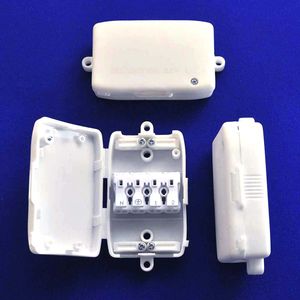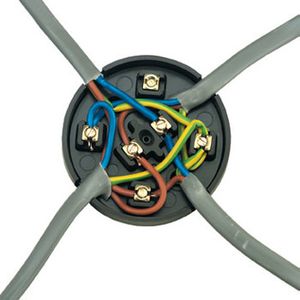Difference between revisions of "Connection Boxes"
(Created page with "Category:Electronic Components{{Knoppen}} <noinclude><!------------------------------------------------ * READ THIS FIRST * Only edit this page if you can improve the conte...") |
|||
| Line 1: | Line 1: | ||
[[Category:Electronic Components]]{{Knoppen}} | [[Category:Electronic Components]]{{Knoppen}} | ||
[[File:Connection box.jpg|thumb|right|Connection Boxes]] | |||
[[File:Connection box1.jpg|thumb|right|Connection Boxes]] | |||
'''Connection Box''' is a container for electrical connections, usually intended to conceal them from sight and deter tampering. A small metal or plastic connection box may form part of an electrical conduit wiring system in a building, or may be buried in the plaster of a wall, concealed behind an access panel or cast into concrete with only the lid showing. It sometimes includes terminals for joining wires. A similar container used for joining wires to electrical switches or sockets is called a pattress. | |||
The term may also be used for a larger item such as a piece of street furniture. In the UK, this is sometimes called a cabinet. | |||
Connection boxes form an integral part of a circuit protection system where circuit integrity has to be provided, as for emergency lighting or emergency power lines, or the wiring between a nuclear reactor and a control room. In such an installation, the fireproofing around the incoming or outgoing cables must also be extended to cover the onnection box to prevent short circuits inside the box during an accidental fire. | |||
Connection box installed as part a photovoltaic system does not need to be listed to UL standard 1741 unless it is used as a solar combiner box. | |||
Latest revision as of 23:03, 16 January 2013
Connection Box is a container for electrical connections, usually intended to conceal them from sight and deter tampering. A small metal or plastic connection box may form part of an electrical conduit wiring system in a building, or may be buried in the plaster of a wall, concealed behind an access panel or cast into concrete with only the lid showing. It sometimes includes terminals for joining wires. A similar container used for joining wires to electrical switches or sockets is called a pattress.
The term may also be used for a larger item such as a piece of street furniture. In the UK, this is sometimes called a cabinet.
Connection boxes form an integral part of a circuit protection system where circuit integrity has to be provided, as for emergency lighting or emergency power lines, or the wiring between a nuclear reactor and a control room. In such an installation, the fireproofing around the incoming or outgoing cables must also be extended to cover the onnection box to prevent short circuits inside the box during an accidental fire. Connection box installed as part a photovoltaic system does not need to be listed to UL standard 1741 unless it is used as a solar combiner box.

